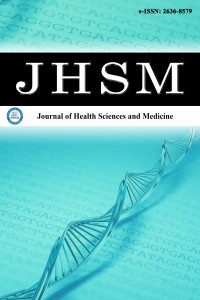1.
World Health O. Coronavirus disease 2019 (COVID-19): situation report, 114. Geneva: World Health Organization; 2020 2020-05-13.
2.
Dogruel H, Balci MK. Development of therapeutic options on type 2 diabetes in years: Glucagon-like peptide-1 receptor agonist’s role intreatment; from the past to future. World J Diabetes. 2019;10(8):446-453. doi:10.4239/wjd.v10.i8.446
3.
Saeedi P, Petersohn I, Salpea P, et al. Global and regional diabetes prevalence estimates for 2019 and projections for 2030 and 2045: results from the International Diabetes Federation Diabetes Atlas, 9<sup>th</sup> edition. Diabetes Res Clin Pract. 2019;157:107843. doi:10.1016/j.diabres.2019.107843
4.
Satman I, Omer B, Tutuncu Y, et al. Twelve-year trends in the prevalence and risk factors of diabetes and prediabetes in Turkish adults. Eur J Epidemiol. 2013;28(2):169-180. doi:10.1007/s10654-013-9771-5
5.
Maddaloni E, Buzzetti R. COVID-19 and diabetes mellitus: unveiling the interaction of two pandemics.Diabetes Metab Res Rev. 2020;36(7): e33213321. doi:10.1002/dmrr.3321
6.
Xue T, Li Q, Zhang Q, et al. Blood glucose levels in elderly subjects with type 2 diabetes during COVID-19 outbreak: a retrospective study in a single center. MedRxiv. 2020;3(31):20048579. doi:10.1101/2020.03.31.20048579
7.
Pal R, Banerjee M, Yadav U, Bhattacharjee S. Clinical profile and outcomes in COVID-19 patients with diabetic ketoacidosis: a systematic review of literature. Diabetes Metab Syndr. 2020;14(6):1563-1569. doi:10. 1016/j.dsx.2020.08.015
8.
Banerjee M, Chakraborty S, Pal R. Diabetes self-management amid COVID-19 pandemic. Diabetes Metab Syndr. 2020;14(4):351-354. doi:10. 1016/j.dsx.2020.04.013
9.
Ruiz-Roso MB, Knott-Torcal C, Matilla-Escalante DC, et al. COVID-19 lockdown and changes of the dietary pattern and physical activity habits in a cohort of patients with type 2 diabetes mellitus. Nutrients. 2020; 12(8):2327. doi:10.3390/nu12082327
10.
Ghosal S, Sinha B, Majumder M, Misra A. Estimation of effects of nationwide lockdown for containing coronavirus infection on worsening of glycosylated haemoglobin and increase in diabetes-related complications: a simulation model using multivariate regression analysis. Diabet Metab Syndr. 2020;14(4):319-323. doi:10.1016/j.dsx. 2020.03.014
11.
Rubinstein A, Koffler M, Villa Y, Graff E. The Gulf War and diabetes mellitus. Diabet Med. 1993;10(8):774-776. doi:10.1111/j.1464-5491.1993.tb00163.x
12.
Önmez A, Gamsızkan Z, Özdemir Ş, et al. The effect of COVID-19 lockdown on glycemic control in patients with type 2 diabetes mellitus in Turkey. Diabetes Metab Syndr. 2020;14(6):1963-1966. doi:10.1016/j.dsx.2020.10.007
13.
Verma A, Rajput R, Verma S, Balania VKB, Jangra B. Impact of lockdown in COVID-19 on glycemic control in patients with type 1 diabetes mellitus. Diabetes Metab Syndr. 2020;14(5):1213-1216. doi:10.1016/j.dsx. 2020.07.016
14.
Alshareef R, Al Zahrani A, Alzahrani A, Ghandoura L. Impact of the COVID-19 lockdown on diabetes patients in Jeddah, Saudi Arabia. Diabetes Metab Syndr. 2020;14(5):1583-1587. doi:10.1016/j.dsx.2020.07. 051
15.
Ghosal S, Sinha B, Majumder M, Misra A. Estimation of effects of nationwide lockdown for containing coronavirus infection on worsening of glycosylated haemoglobin and increase in diabetes-related complications: a simulation model using multivariate regression analysis. Diabet Metab Syndr. 2020;14(4):319-323. doi:10.1016/j.dsx. 2020.03.014
16.
Nasri H, Yazdani M. The relationship between serum LDL-cholesterol, HDL-cholesterol and systolic blood pressure in patients with type 2 diabetes. Kardiol Pol. 2006;64(12):1364-1371.
17.
Verma A, Rajput R, Verma S, Balania VKB, Jangra B. Impact of lockdown in COVID-19 on glycemic control in patients with type 1 diabetes mellitus. Diabetes Metab Syndr. 2020;14(5):1213-1216. doi:10.1016/j.dsx. 2020.07.016
18.
Fernández E, Cortazar A, Bellido V. Impact of COVID-19 lockdown on glycemic control in patients with type 1 diabetes. Diabetes Res Clin Pract. 2020;166:108348. doi:10.1016/j.diabres.2020.108348
19.
Dover AR, Ritchie SA, McKnight JA, et al. Assessment of the effect of the COVID-19 lockdown on glycaemic control in people with type 1 diabetes using flash glucose monitoring. Diabet Med. 2021;38(1):e14374. doi:10.1111/dme.14374
20.
Wu J, Xiao J, Li T, et al. A cross-sectional survey on the health status and the health-related quality of life of the elderly after flood disaster in Bazhong city, Sichuan, China. BMC Public Health. 2015;15:163. doi:10. 1186/s12889-015-1402-5

